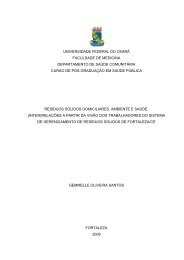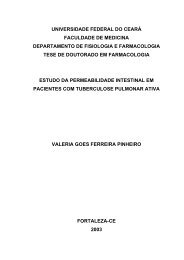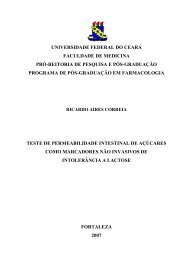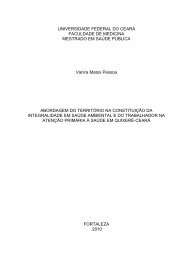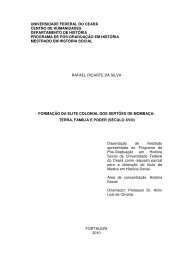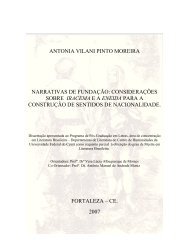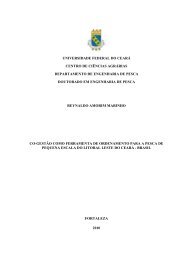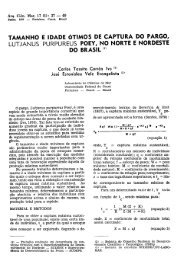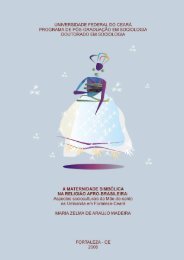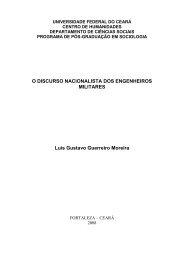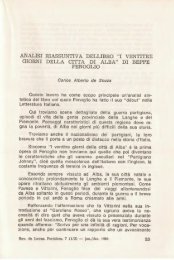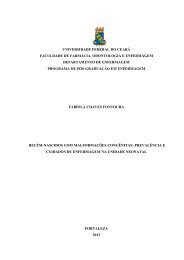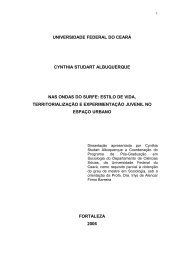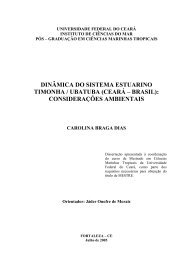Tungíase: doença negligenciada causando patologia grave
Tungíase: doença negligenciada causando patologia grave
Tungíase: doença negligenciada causando patologia grave
You also want an ePaper? Increase the reach of your titles
YUMPU automatically turns print PDFs into web optimized ePapers that Google loves.
Tropical Medicine and International Health volume 15 no 7 pp 856–864 july 2010<br />
L. Ariza et al. Rapid community assessment of tungiasis<br />
Table 4 Estimated and true prevalences of tungiasis and severe tungiasis (>20 lesions)<br />
Brazil Nigeria<br />
1 2 3 4 5 6 7 8 9 10<br />
Prevalence of tungiasis 37.8% 42.0% 21.1% 28.8% 18.8% 44.3% 15.0% 20.8% 44.1% 30.2%<br />
on periungual sites<br />
Prevalence of tungiasis<br />
True prevalence 51.3% 52.1% 31.2% 33.6% 23.7% 54.4% 21.1% 28.9% 51.1% 40.5%<br />
Estimated prevalence 47.3% 52.0% 28.7% 37.2% 26.0% 54.6% 21.8% 28.3% 54.4% 38.8%<br />
(95% CI)<br />
(43.0–51.5) (47.6–56.5) (24.8–32.6) (34.6–40.0) (23.5–28.6) (51.1–58.8) (21.8–24.4) (25.5–31.2) (46.9–61.6) (30.0–48.3)<br />
Absolute error )4.0% )0.1% )2.5% 3.6% 2.3% 0.2% 0.7% )0.6% 3.3% )1.7%<br />
Prevalence of severe<br />
tungiasis (>20 lesions)<br />
True prevalence 6.0% 6.5% 2.8% 2.2% 1.3% 4.7% 0.1% 0.8% 10.2% 5.2%<br />
Estimated<br />
5.7% 6.7% 1.7% 3.5% 1.1% 7.2% 0.2% 1.6% 7.2% 3.8%<br />
prevalenceà (95% CI) (3.9–7.9) (4.7–9.2) (0.7–3.1) (2.5–4.7) (0.6–2.0) (5.5–9.1) (0.0–0.7) (0.9–2.6) (3.8–11.7) (0.9–8.6)<br />
Absolute error )0.3% 0.2% )1.1% 1.3% )0.2% 2.5% 0.1% 0.8% )3.0% )1.4%<br />
According to the equation y = 1.12 (x) + 5.0 where x is the prevalence determined to the rapid assessment method and y the estimated prevalence.<br />
àAccording to the equation y = 0.24 (x) – 3.4 where x is the prevalence determined to the rapid assessment method and y the estimated prevalence.<br />
examination. Thus, rapid diagnosis on the individual level<br />
with calculation of accuracy markers, such as sensitivity, is<br />
not needed in this case. On the other hand, reliable<br />
estimation of the true prevalence of tungiasis and severity<br />
of disease in a given community is useful. Our study shows<br />
that the strength of association when applying the rapid<br />
estimation was very high.<br />
In communities of different size and with different point<br />
prevalences, absolute errors of the estimated prevalences<br />
were low and R 2 values were high. The reliability of the<br />
proposed rapid assessment method did not vary considerably<br />
between seasons or populations with distinct<br />
socio-cultural characteristics. The wide diversity of<br />
characteristics of the examined populations indicates that<br />
this rapid assessment method may also be applicable in<br />
other endemic regions in Latin America, the Caribbean or<br />
sub-Saharan Africa. However, its external validity still has<br />
to be determined for other settings with particular<br />
ecological, epidemiological, geographical and sociocultural<br />
characteristics.<br />
We cannot rule out that inter-observer as well as intraobserver<br />
bias may have influenced the results, as surveys<br />
were conducted by different members of the research<br />
group, and during a rather long period. We aimed to<br />
reduce this source of bias by training all investigators<br />
performing the clinical examinations in one study<br />
site in Brazil, and by cross-checking quality of clinical<br />
examinations.<br />
Conclusion<br />
Our rapid assessment method will be helpful in the<br />
identification of communities at risk, as well as in planning<br />
and monitoring control measures aimed at the reduction of<br />
tungiasis in affected communities. The assessment can be<br />
performed by community health workers and paramedical<br />
personnel.<br />
Acknowledgements<br />
We thank the leaders and the people of the communities<br />
involved. We also thank Fundação Mandacaru for supporting<br />
the studies and Valéria Santos, Vania Santos (Brazil)<br />
and ‘Nick’ (Nigeria) for skillful assistance. Travel grants<br />
were made available by Deutscher Akademischer Austauschdienst<br />
(DAAD ⁄ Germany) and by Coordenação de<br />
Aperfeiçoamento de Pessoal de Nível Superior<br />
(CAPES ⁄ Brazil), through the PROBRAL German-Brazilian<br />
Academic Exchange Program, and by a PROÁFRICA grant<br />
from the Conselho Nacional de Desenvolvimento Científico<br />
e Tecnológico (CNPq ⁄ Brazil). L.A. received a PhD scholarship<br />
from CAPES. J.H. is research fellow from CNPq.<br />
862 ª 2010 Blackwell Publishing Ltd



